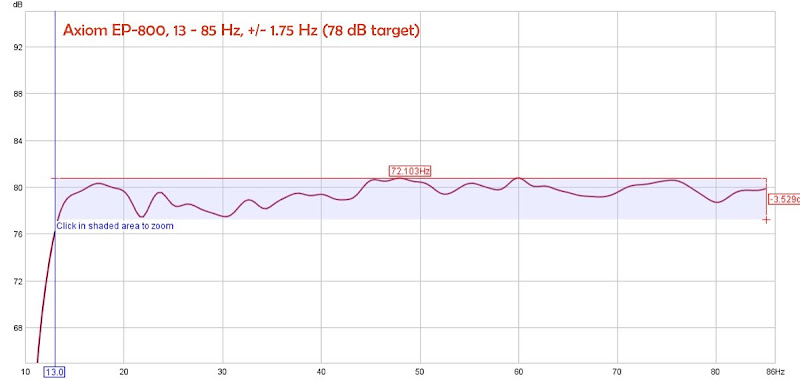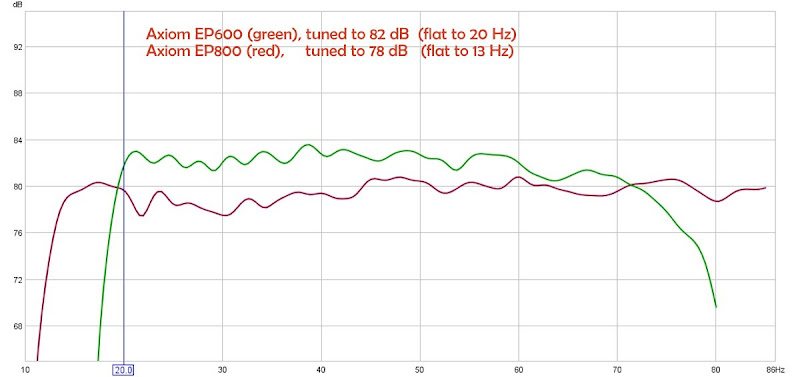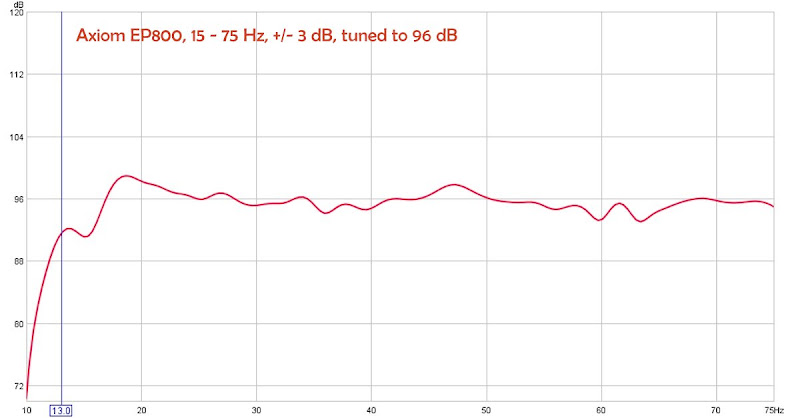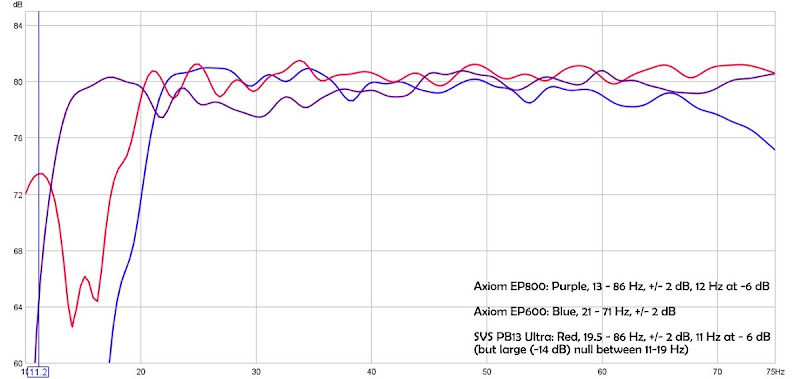I still can't post a complete review (I don't feel I've spent enough time listening to do so), but I can share with you a lot of measurements and some thoughts on my experience with the 800 thus far.
Keep in mind that in all measurements below (unless otherwise stated), I am running two subwoofers. The second sub is always my Earthquake Supernova MKIV-12" sealed sub that I place in the rear of my room to flatten overall response. (it only plays flat down to around 35 Hz, so all of the heavy lifting is always done by the EP600/800/PB-13)
As many of you remember, in the past I spent considerable time
conducting a shootout between the PB13 Ultra and the Axiom EP600. There were two series of blind listening tests with multiple participants. The previous link is to the first series of impressions, this link takes you to
my final results and decision.With that as background, I set out to compare the EP800 to both the 600, which I still have, and the PB-13 Ultra, which I can do fairly well from a measurement perspective as I have all of the old FR curves I captured then. Beyond the FR curves, though, it's hard to give anything but a very subjective comparison between the two, which I'll happily do, but with that caveat.

So, let's begin with a response curve for the EP800 after being tuned through the Behringer Feedback Destroyer Equalizer (BFD). You'll see as you read below that I've gone through several rounds of this. The curve below is the first (and incidentally, the flattest) I was able to achieve with the EP800 & BFD.
EP-800, Initial BFD tuning:
As I think you'll agree, the results are impressive. The EP800 plays from 13 Hz to my crossover point at an impressively tight +/- 1.75 dB (in my main listening position, which is my primary concern). In addition to it being "calista flockhart" flat (a term coined here during an earlier review), the EP800 also lives up to it's billing of playing very low, considerably lower than I've been able to achieve with the EP600.
On that note, a few words on the direct comparison between these two subwoofers.
EP600 versus EP800 ComparisonWhile the EP600 is an incredibly capable sub, its minor annoyances (to me at least) include the artifacts that come along with a ported sub. Many people probably never notice this (I don't see it mentioned here much), but on incredibly demanding home theater scenes, the EP600 will exhibit a slight chirp of port noise. (To put this into perspective, this occurs in ~1-2% of all movies I've ever watched, and never during music) Nevertheless, it does happen, and is one of the reasons I put the money down for an upgrade to the EP800.
As I'm sure is obvious, the sealed EP800 does not suffer from this, so that is a welcome change for me. Aside from that though, how do the two subs compare? In my very modestly-sized room, I put very little focus on maximum SPL as any quality sub is capable of more than enough output to handle even loud listening volumes in my enclosed room. Flat and low frequency extension, however, is of paramount importance, and here, the EP800 absolutely does not disappoint. Below is a graph comparing the observed results in my room between the EP600 and the EP800.

As you can see, in my room, the 800 gives me a full 7 Hz more in the nether regions of LFE, which may sound like a minor improvement, but the effects are quite apparent. Don't be fooled by the difference in output between the two lines. Note in the text that I was tuning the 600 to a higher output at the time, it does not indicate that the 600 plays louder than the 800.
But is it LOUD?So, we've looked at how flat the EP800 plays, but what about putting it through its paces and cranking it up? Sure it can play flat at 78 dB, but what if I want to play LOUD? Even though it has more than enough output to destroy my room and I will likely rarely task it to this level, I decided to crank it up a bit and see if it could maintain a flat response across this range at a much higher output. The results are below:

In this graph, there is an 8 dB rolloff to 13 Hz, but the response is otherwise flat from 15 - 75 Hz. I suspect that at least some of the rolloff is due to room effects and unfortunately the BFD is not capable of any sort of equalization below 20 Hz, so my ability tweak that low is nil. (they didn't plan for a sub like the EP800 when they built it!)
Just to test this theory, I played a test tone at 13 Hz and turned up the gain manually to see how loud it would go (or how loud I could stand it). When it hit 103 dB at 13 Hz, I decided to give up.
(Yes, 103 dB at 13 Hz!) Keep in mind that my gain dial on the back of the 800 isn't even at the halfway mark, but I literally could hear and feel the drywall in the back walls of my theater shaking when going to 103 dB, so I didn't feel like taking it any louder.
So, to answer the question above, "Is it Loud?" Yes, it is.
 And what about the SVS PB13-Ultra?Before reading this, re-read my introduction and the caveats about my comments about the PB13. I did not do a side by side comparison, these are measurement comparisons only, and they were taken at different times.
And what about the SVS PB13-Ultra?Before reading this, re-read my introduction and the caveats about my comments about the PB13. I did not do a side by side comparison, these are measurement comparisons only, and they were taken at different times.The SVS can be tuned to several different modes (10,15,20 Hz, etc.) For this comparison, I'm using the measurements taken from the 10 Hz mode as it seems to most closely resemble the extension of the EP800. Below are the best results I was able to achieve with both subs in my room.
The graphs below include the EP600 as well to show a complete comparison between the three.

As the graph shows,
in my room the EP800 extends its flat response significantly deeper, but it is again important to note that this is likely largely impacted by room effects as I did not have my home theater chairs in the room when I tested the PB13, so this is not an entirely apples to apples comparison. I've seen several frequency response charts that show the SVS playing with only a modest roll off down to 10 Hz, so I believe this chart belies its capabilities to some degree (though you'll note it did have slightly more output at 10 Hz than the 800).
Closing thoughtsIf you're still with me after all of the info above, congrats!

Like I said in the opening, I still feel like it's too early for me to give my complete thoughts on the performance of this sub across all types of source material, but from what I've experimented with so far (which includes most of my favorite bass-heavy demo scenes and little else), I can say that I am extremely happy with the EP800, and that it is unquestionably an upgrade from the EP600 that is well worth the money.
For me, even without completing more exhaustive listening tests, I am confident in saying that this is the last sub I'll buy for a very very long time. And yes, I realize what a dangerous thing that is for a home theater fanatic to say, but I don't feel even the slightest misgiving as I type it. I've been looking for the 'perfect sub' for a long time, and to me, the EP800 is exactly that. It delivers incredibly flat frequency response, heart stopping volume, and comes in an absolutely stunning high-gloss cherry package with Axiom's always-awesome customer service as icing on the cake.
What more could you possibly ask for?




